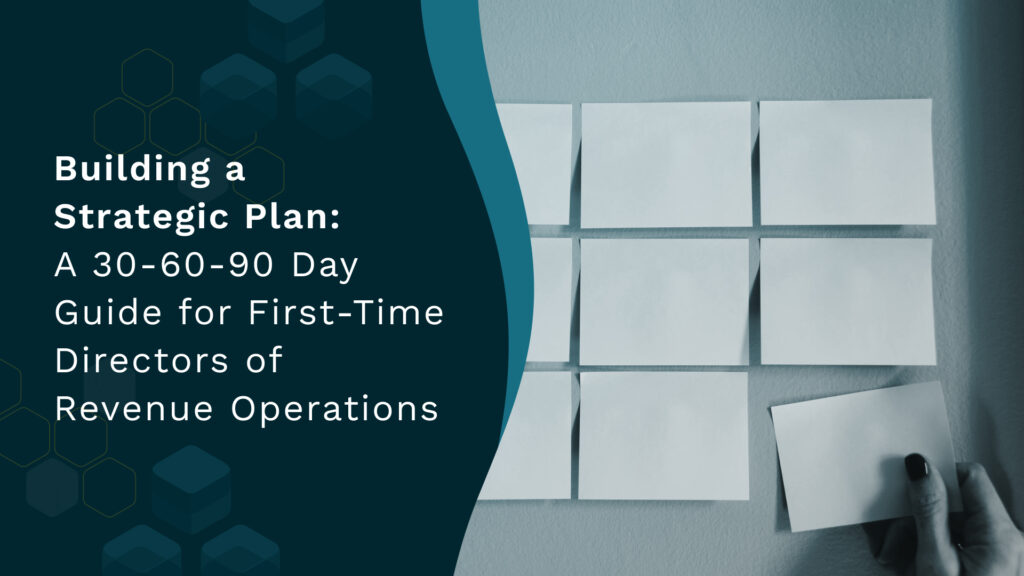
Planning a Salesforce Data Migration? Don’t Leave Behind Crucial Activity Data!
Ensure a successful Salesforce data migration with this guide: Don't overlook critical activity data for a seamless transition and data integrity
Salesforce data migration is a challenging project for most operations leaders.
Your CRM system contains critical information about your customers that can help drive positive business outcomes. When you decide to migrate to a new CRM system like Salesforce, you don’t want to lose out on this valuable data from the old system.
But loss of critical activity data during Salesforce data migration is common. This loss directly translates to missed opportunities that already exist in your CRM.
In this article, we will explore the challenges related to capture of activity data while migrating your CRM to Salesforce. And how you can avoid this major pitfall with the right data strategy.
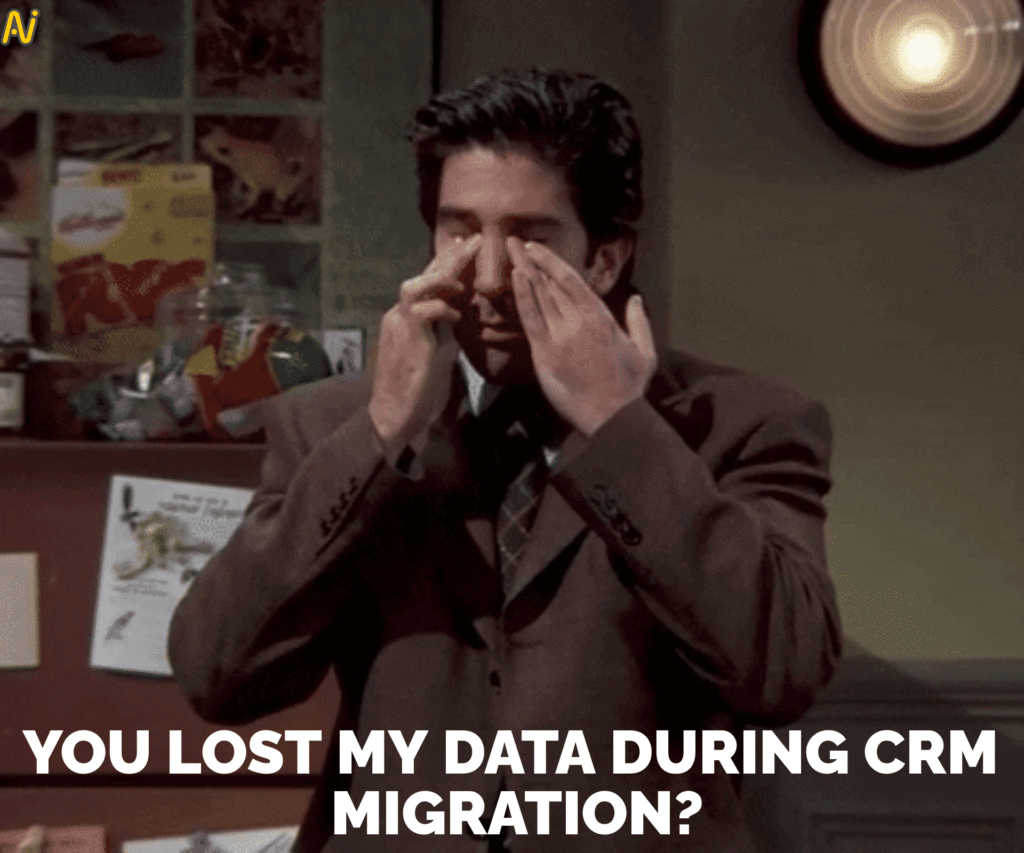
Activity Data Loss During Salesforce Data Migration
The biggest problem during Salesforce data migration is loss of historical data. This does not include data related to opportunities and accounts in the old CRM. This data loss caters to multiple fields within opportunities. Examples include email exchanges, opportunity contacts, or notes associated with deals.
With such crucial activity data missing, revenue teams lose sight of many deals. With the loss of this activity data, revenue leaders miss out on finding answers to critical questions that move the revenue needs.
Examples include:
- How many emails were exchanged?
- What was the context of those emails?
- Who were the contacts involved in the deal?
- What was the role these contacts were playing in the purchase process?
- What were the pricing related details that came up during conversations?
These granular details give a clear view of the sales pipeline to revenue leaders. And armour them with information they can use to coach their reps better and lock in more deals every quarter. This data also provides leading indicators that can act as predictive measures of future performance.
Despite best efforts, this revenue data gets lost during Salesforce data migration. There are different data transfer woes operations leaders face when they migrate their CRM to Salesforce.
- Failure to transfer the data under the right fields. For example, instead of going under the “opportunity” field, it might get fed into the “account” field. The ability to parse the metadata from Gmail to get into Salesforce remains a challenge.
- Even if the data gets added to Salesforce, the activity data is mostly of the migration date and not the actual date in which the activity actually took place. This makes the information lose its relevance.
- There is a chance of losing a lot of other data from the old CRM while migrating to Salesforce.
While most CRMs do offer plugins to transfer activity data into Salesforce, these plugins do not work effectively under all conditions. As a result, they end up being unreliable mediums to capture data.
Most tools also require the contacts to be already in Salesforce for the activity to be captured. When nobody adds the contacts, associated activities automatically get missed out from the new CRM.
5 Alarming Consequences of Data Loss
The consequences of activity data loss during a CRM data migration can have catastrophic effects on your business.
Data loss can cause a direct dent on your revenue engine. Let’s look at some of these alarming consequences:
1. Poor deal reviews
Deal reviews form an integral part of closing more sales. It helps sales managers know what’s going on in their pipeline, and devise strategies to pivot wherever necessary to avoid risks.
Data is the fuel that runs successful deal reviews. To conduct effective reviews and 1-1 coaching sessions, sales teams need access to the right data. They also need to be able to use that data to drive intelligence across the revenue engine.
But with lost data during migration, sales teams lose access to critical revenue data that can help them close more opportunities during the quarter. And with missing data, organizations fail to create those data-driven strategies that can help devise successful sales strategies.
For example, backing up data in deal reviews during CRM data migration becomes questionable. Without historical data and associated activities getting tracked, sales teams won’t know which stakeholders are a part of the buying committee.
In short, without the right data, deal reviews fail to make sales teams more successful. The results in failed campaigns to drive sales forward, more gaps in the selling process, frustrated sales teams and inability to meet quotas.
2. Inaccurate sales forecasting
Sales forecast is a critical element of running a successful revenue operations function. With sales forecasting numbers, revenue leaders are in a better position to carefully align resources towards the right areas.
But less than 50% of sales leaders and sellers have high confidence in their forecasting accuracy. Without the right data at the right place, making accurate sales forecasts becomes very challenging.
To be able to make an accurate forecast, revenue leaders need access to historical data to get a visibility of how the sales pipeline is progressing at an organizational level. Bit losing this critical data during a migration project translates into lack of clarity into critical questions like:
- Which are the deals moving towards closure this quarter?
- What is the stage different deals are at?
- Which deals are not likely to close?
Longer sales cycles, missed quotas and an unclear picture of deals make predicting accurate sales figures an ambiguous exercise. And relying on human tendencies like guesswork and instinct give rise to ambiguous forecast numbers.
Complete and trustworthy data in CRM and other GTM tools is the first step to achieving confidence in sales forecasts. Without this unified data visibility, sales teams fail to focus on the right deals and fall prey to risks that fail to predict the fate of their deals.
3. Surge in operational cost
The loss of data during Salesforce data migration is usually realized when the decision to migrate to Salesforce has already been taken. This puts businesses in panic mode as the possibility of significant data loss hits them in the last few days of the migration.
The second realization that hits organizations is that both CRMs have a different way of working. For example, if you’re migrating from Hubspot to Salesforce, the way HubSpot captures activity data is significantly different from the way Salesforce captures data.
So the historical activity and the existing or future activity that is going to happen, chances are high that Salesforce will miss out on both of them.
Because these realizations mostly hit operations leaders during the migration process, there are added operational costs that come along with mitigating these risks.
For example, we have seen our clients extend the use of their old CRM till they mitigate the risks of data loss. This adds to overhead costs of continuing payment for the old CRM, and also added cost of paying for Salesforce.
In addition to added license cost, there are invisible costs relating to productivity loss and training people on the new CRM, the amount of time that gets wasted in figuring things out.
4. Productivity loss due to poor adoption
Getting a new CRM and getting your teams to use it are two completely different issues. And with Salesforce data migration, getting your sales and marketing folks to start using it becomes a bigger beast.
54% of sales teams do not use their CRMs. There are several reasons for this such as reduced time in selling, or CRMs reporting features that only help executives and not sellers.
But most importantly, sellers do not trust the data in their CRM. According to Gartner, poor CRM adoption continues to be a massive challenge for organizations. And any new CRM system means businesses also need to invest in the training of their employees so that they can get them to use it.
“Losing data at any point is an issue as data builds upon itself to become useful. So losing some hurts all of it. The best ways to tackle it is to ensure excellent internal adoption so everyone inputs correctly to make the migration as easy as possible and then to have quality people do the migration so they understand where to look and how to move it over. If there is a trusted tool that plays with everything in a data transfer arena, that would be ideal.”
Respondent, RevOps Evangelist
Adoption is a big challenge for CRM. If adoption is poor, data is not complete and people don’t trust any analytics coming out of it. Without clean and complete data, any analytics that you do will be incorrect. If you’re going to be doing a lot of toggling, go back to excel, adoption will continue to remain a big challenge.
If you are toggling for a long time between two platforms, then nobody is confident about the data in the new system – then they will continue using the old system, they will continue using excel.
5. Poor ROI from marketing campaigns
Effective and personalized account-based marketing campaigns are proven ways to increase revenues by 5 to 15 percent. But to run personalized campaigns, businesses need access to data that tells them about their buyer personas beyond simple phone numbers and email addresses. And with data loss, the ROI from such campaigns becomes a big question mark.
A majority of revenue leaders from our survey don’t feel confident in their ability to create personalized, omnichannel buying experiences at scale. As less as 15% of CMOs believe their company is on the right track with personalization.
Such data quality shortcomings in CRMs are making marketing and sales teams underperform and fail on their personalized outreach strategies.
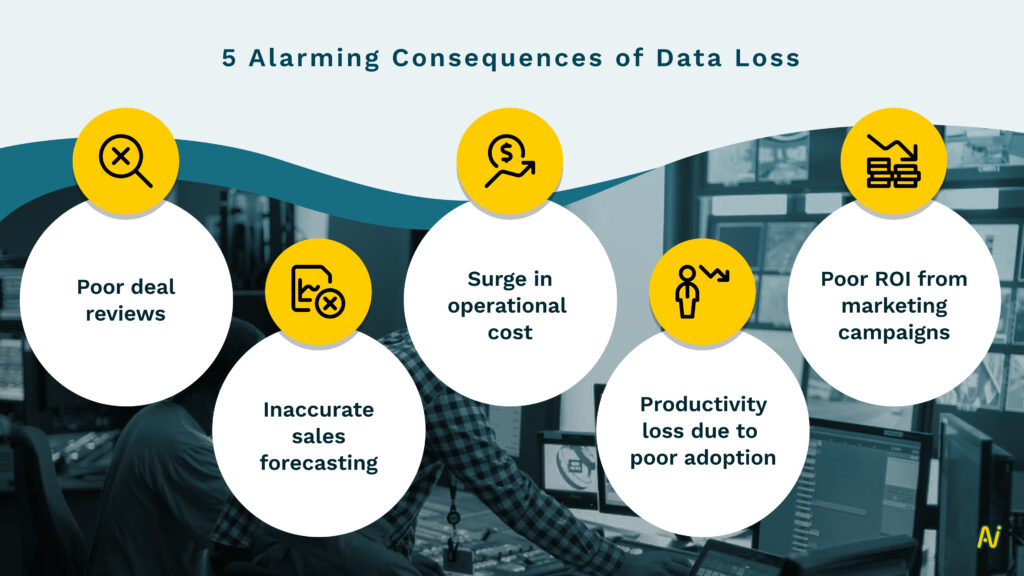
Addressing the Data Leakage During Salesforce Data Migration
So how can you successfully migrate your CRM to Salesforce without losing out on the critical data from your existing CRM system? The answer is through the right approach to data strategy.
When you are designing a system, design it in a way that gives you full accessibility to your data. You either work with third parties that are designed to aggregate the existing granular data or capture data, and put that together in a separate system. Most of my clients that really grasp this well are the ones that work with third party platforms that bring the data from multiple sources. And use the power of business intelligence to showcase that information. That I think is a critical decision (for successful CRM data migration).
Craig Handy, Director, Revenue Operations & GTM Strategy at York ie
Most CRM data migration efforts fail because of reasons relating to data. The data in your CRM and the data that you will migrate to Salesforce is what will drive its ROI. The quality of the data in your CRM and the way it is handled during the migration will impact the success of your CRM data migration.
Another reason why CRM migration fails is the long stabilization or adoption period for teams to get accustomed to the new CRM. Your GTM teams don’t trust the data in the new CRM. This lack of trustworthy data means they either keep using the older system or go back into logging their activities in excel sheets.
Before you even begin to answer this question, here are some preliminary areas to dig into with respect to automation:
1. Clean and prep your existing data
CRM data entry in itself is riddled with complications. The data in your current CRM might also be a mess. Poor quality, missing contacts, duplicate data – the inefficiencies can manifest in varied forms. And as more data keeps getting added into your CRM, this problem can turn your CRM into a Frankestein monster.
The first step is to inspect your data and ensure it is of good quality. By good quality, we mean it’s accurate, complete and trustworthy for your reporting needs. You can do this by investing in automation that eliminates the dependence on manual data entry.
Tools that sync your CRM with your Gmail/Outlook, sales enablement tool, or any kind of tool you might have in your tech stack through APIs can help you capture all this data automatically.
2. Continually enrich your data
Even if the data in your CRM is accurate and clean today, it might not be so in the near future. CRM data gets stale at a ridiculously fast rate of 70% per year. You need an automated way of eliminating irrelevant data from your CRM and adding fresh contacts as and when they enter your pipeline.
Automation can take care of the enrichment part of your CRM data. CRM data enrichment is a process that enhances, refines and improves the data in your CRM that gets collected through marketing campaigns or sales efforts.
It strengthens the value of your data by making it richer. It strengthens the profile information of your current and potential customers of a business.
A manual approach to data cleansing every now and then is not sustainable. An automated CRM data enrichment tool ensures that the data in your CRM is always updated. And there are no duplicates, missing or inaccurate data in your CRM.
3. Bring in automation into logging activities from multiple sources
Ensuring CRM data completeness during migration is key to making Salesforce data migration a successful exercise. Capturing relevant, clean and complete data into Salesforce and maintaining its integrity can give a true view of enriched data and pipeline progression to revenue leaders.
But how do you capture this activity data? Especially when it’s trapped in multiple siloed systems? Your data related to ongoing opportunities might be trapped across disconnected systems and teams. This disconnectedness makes it impossible to find answers at the time of need.
The way to do this effectively is to sync your data from multiple sources, be it your email conversations, your calendar activities, your meetings, messages or dialers – and automatically plug it into Salesforce.
Nektar Makes Salesforce Data Migration Simpler
Nektar’s Unified Activity Capture Solution addresses the huge CRM data gap at its roots. An API to API integration platform with deep integrations with Salesforce and GSuite, Nektar eliminates the need for clunky plugins or extensions during a CRM data migration process.
With Nektar, you can:
- Automatically capture data from different sources like inbound, outbound or your calendar activities and update it in Salesforce.
- Track missing contacts by scanning your emails (cc, bcc) and add them into Salesforce. Your sales and marketing teams have more first-party contacts to reach out to.
- Capture email signatures from emails and log it into Salesforce. This gives your sales team wider access to the buying group and enables them to multithread with relevant stakeholders.
- Automatically identify accounts and the opportunities running within those accounts. Nektar contextually maps contacts against accounts and active opportunities without any need for manual intervention
Nektar requires zero manual intervention and works in harmony with all your other tools silently in the background. Your teams do not have to learn something new. Or get used to a new environment. This automatically eliminates the challenge to tool adoption.
Nektar’s unified activity capture solution assures this CRM completeness with best-in class accuracy.
With this automatic mining of on-ground activity data and historical backmining of data, revenue leaders can have a clear visibility into what is happening with every account and every opportunity in their CRM. With all the activity data unified under one roof, reports and details can be pulled out at the time of need from a single place.
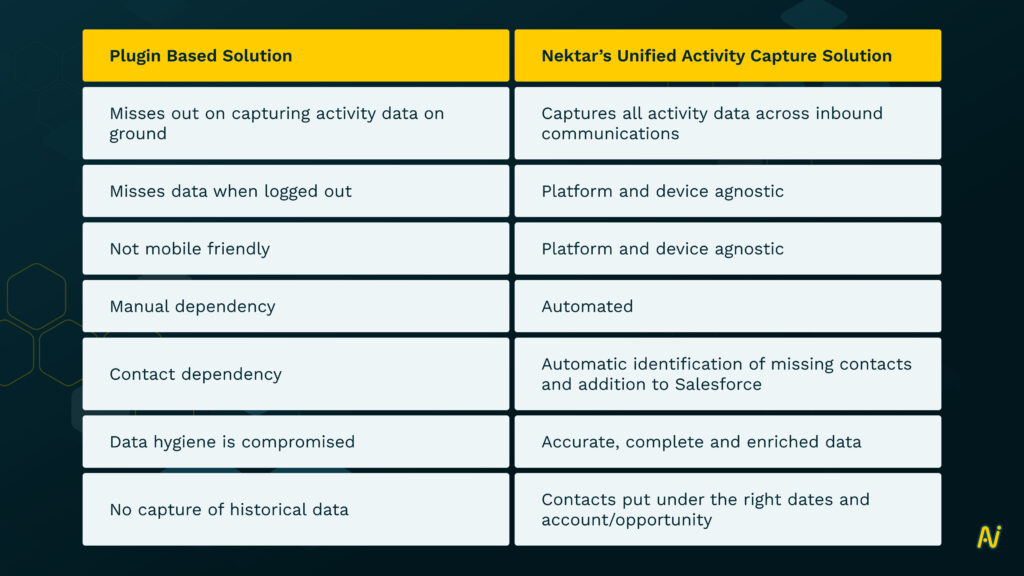
So, if you’re also migrating from your current CRM to Salesforce and worried about losing activity data, we are here to help. In addition, you get the following table stake benefits:
- No tool adoption needed
- No-code and highly configurable platform (buyer persona mapping, boards, etc)
- No manual entry, ever; frees up rep time to act on closing deals faster
- Integrations and connectivity – import Nektar data into any of your existing BI tools
- Security certifications and data privacy
With Nektar going LIVE alongside your CRM migration to Salesforce rollout, your teams will see a massive productivity gain without having to learn a new platform.
Simplify Salesforce Data Migration With Nektar.
So are you ready to never lose out on activity data again?
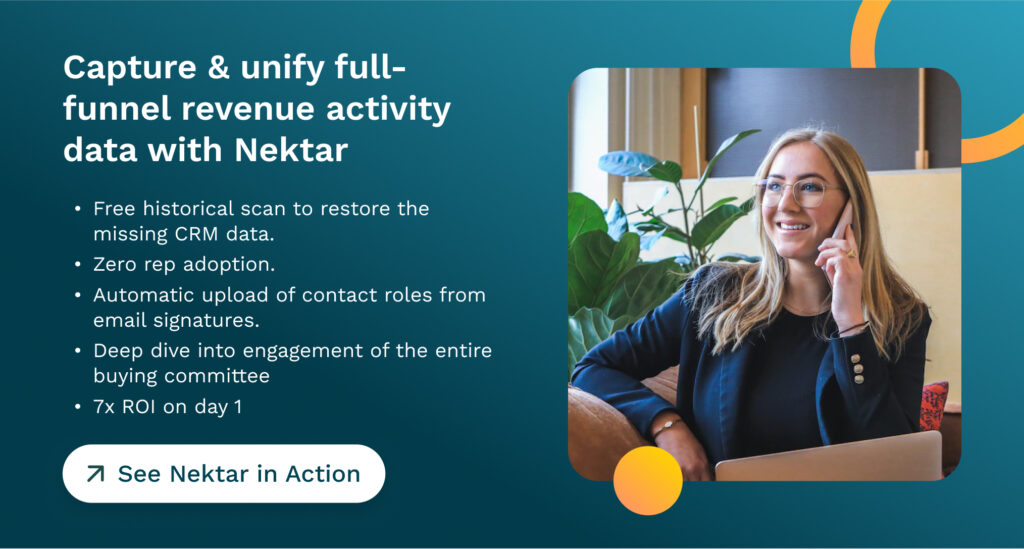
PUBLISHED BY
